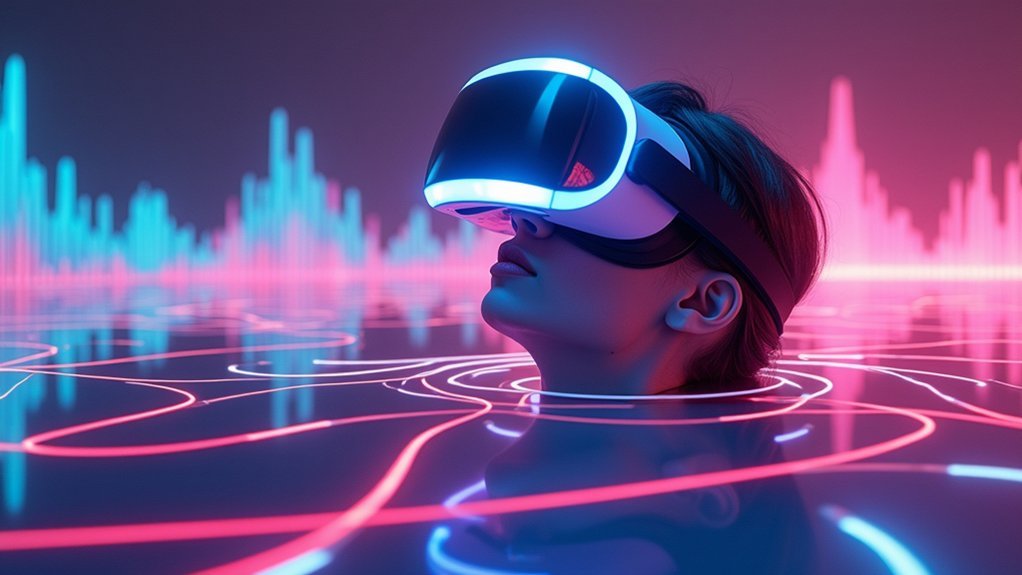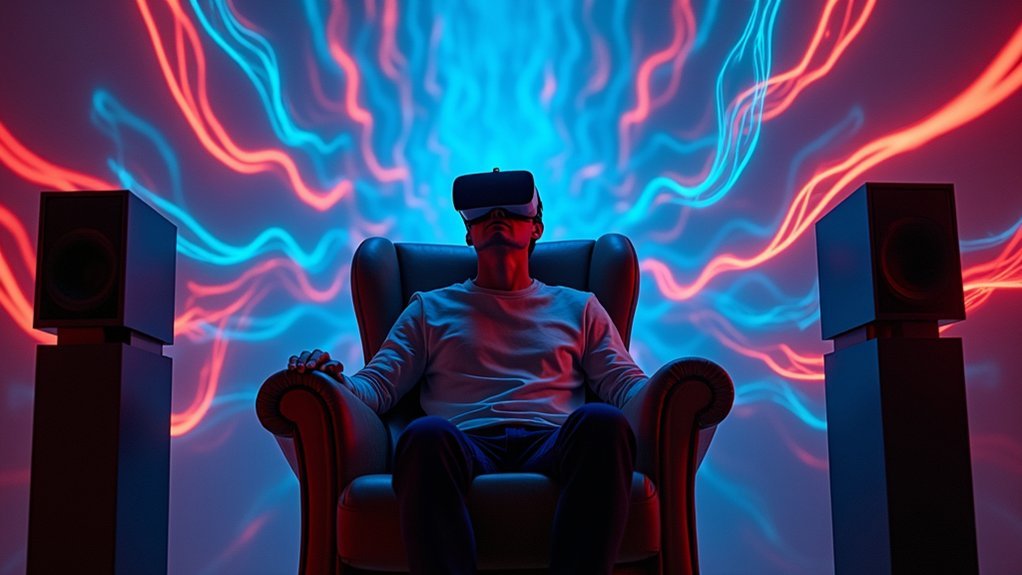Spatial audio transforms your VR experience by creating immersive 3D sound environments where you’ll hear sounds positioned accurately around you, unlike stereo’s flat presentation. You’ll experience enhanced realism through precise audio localization that lets you identify sound sources from any angle with natural distance perception. Most importantly, you’ll eliminate the unnatural “in-head” effect that traditional headphones create, achieving authentic spatial awareness that perfectly aligns with what you’re seeing for maximum presence and engagement.
Immersive 3D Sound Environment Creates True Presence

Stepping into a virtual world feels incomplete without your ears matching what your eyes see. Spatial audio creates an immersive 3D sound field that surrounds you completely, unlike traditional stereo’s limited left-right channels.
Through head-related transfer functions (HRTFs), VR systems precisely position sounds above, below, and around you, delivering authentic auditory cues that align with visual elements.
Head tracking technology updates audio direction in real time as you move, ensuring sounds maintain their spatial relationships. When you turn left, that approaching helicopter stays on your right where it belongs.
This spatial audio synchronization creates genuine presence within the virtual environment. The immersive experience transforms dramatically when your brain receives consistent spatial information from both sight and sound, making the digital world feel convincingly real.
Enhanced Realism Through Accurate Audio Localization
When your brain processes audio cues that perfectly match visual information, VR transforms from digital simulation into believable reality.
Spatial audio achieves this through head-related transfer functions (HRTFs) that simulate how sound naturally interacts with your head and ears, creating authentic localization cues your brain recognizes.
HRTFs replicate natural sound interaction with your anatomy, generating the precise acoustic cues your brain needs for authentic spatial perception.
This enhanced realism considerably improves your virtual environment experience through:
- Precise directional awareness – You’ll accurately identify sound sources from any angle, including above and below.
- Natural distance perception – Audio volume and clarity changes match how you’d hear sounds in real life.
- Seamless head movement tracking – Sound positions remain consistent as you turn and move.
This immersive audio localization creates deeper engagement by eliminating the artificial disconnect between what you see and hear in virtual spaces.
Natural Auditory Perception Without In-Head Localization

Traditional stereo headphones create an unnatural phenomenon where sounds appear to originate from inside your head rather than from external sources in the environment.
Spatial audio eliminates this in-head localization by utilizing head-related transfer functions (HRTFs) that simulate how your ears naturally process sound. This immersive audio technology recreates interaural time differences (ITD) and level variations your brain expects, enabling natural auditory perception and precise localization of sound sources.
In VR experiences, 3D sound becomes essential for maintaining immersion. When sound effects appear to come from their correct positions within the virtual environment, you’ll experience authentic spatial awareness.
Your brain processes these audio cues exactly as it would in reality, creating seamless integration between what you see and hear, ultimately delivering convincing VR experiences.
Frequently Asked Questions
What Is the Point of Spatial Stereo?
You’ll experience three-dimensional audio that lets you perceive sounds from all directions, creating realistic spatial awareness. It eliminates in-head localization issues, making sounds appear to come from outside your head naturally.
What Is Spatial Audio in VR?
Spatial audio in VR creates three-dimensional sound that matches your virtual environment. It uses head tracking and advanced techniques to make sounds appear from specific directions and distances, moving naturally as you turn your head.
What Is 3D Stereo Sound?
You’ll experience 3D stereo sound as immersive audio that creates three-dimensional positioning around you. It uses binaural techniques and timing differences to simulate realistic sound placement above, below, and around your listening position.
What Is Beats Spatial Audio?
You’ll experience Beats Spatial Audio as an immersive three-dimensional sound technology that creates realistic audio environments around you, using head tracking and advanced algorithms to position sounds from all directions including above and below.
In Summary
You’ll find that spatial audio transforms your VR experience by creating genuine presence through immersive 3D soundscapes. You’re able to pinpoint exact locations of audio sources, making virtual environments feel authentically real. Most importantly, you won’t experience that artificial “in-your-head” sensation that stereo audio produces. When you’re exploring virtual worlds, spatial audio doesn’t just enhance the experience—it makes it believable. You can’t achieve true VR immersion without proper spatial audio implementation.





Leave a Reply